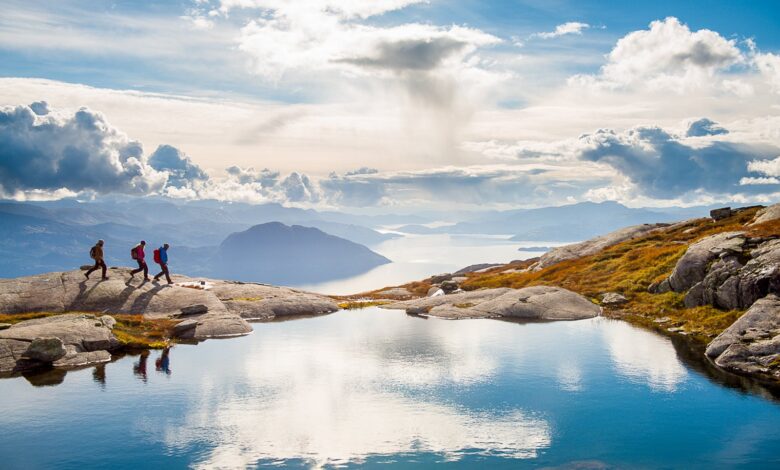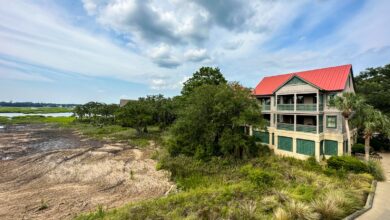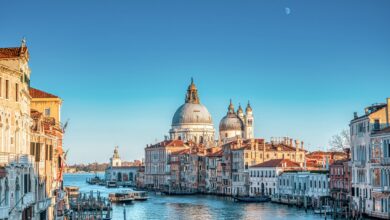How Norway is balancing climate change and moving toward sustainable tourism

If I’m being honest, Norway was not a place that was on my travel bucket list. I live in Arizona, and Norway is very far, very northern and notoriously cold. I also heard that polar bears outnumber people on Svalbard. I’ve lived in the desert for the better part of 25 years, and I like being warm. I also don’t own any cold-weather gear — nothing fit for the Arctic, anyway. Flip-flops are pretty much my year-round go-to, so I wasn’t sure how it was going to go when I was invited to attend a summit taking place in Tromso and Svalbard.
With temperatures in the town of Longyearbyen on the Svalbard archipelago hovering around minus 3 degrees Fahrenheit, I was nervous, to say the least, but I couldn’t turn down a chance to see such a beautiful part of the world. Spoiler alert: Upon arrival, I quickly found this Norwegian saying to be true: “There’s no such thing as bad weather, only bad clothing.”
With the help of Tromso Outdoor, I learned you can just rent a parka and insulated snow boots when you get there, which made all the difference in the world. Comfortably warm, I could focus on the reason for the trip — to witness the effects climate change is having on the Arctic and how Norway is focusing on sustainable tourism practices and green initiatives as it plans for the future.
Feeling the impacts of climate change
Global warming is here already, and many countries worldwide are doing what they can to adapt. This is especially true in locations that are feeling the impacts first.
Northern Norway, also known as Arctic Norway, has been among those places seeing the effects of severe climate change on the environment. It’s showing up in the rapid melting of glaciers, an increase in warming events during the winter and a rise in average temperatures.
As guests of Tourism Cares — a gathering hosted in partnership with Innovation Norway and the United States Tour Operators Association — media, tour operators and destination management organizations from around the world came together for the annual summit. This allowed guests, such as myself, to witness the effects of climate change in Tromso and Svalbard firsthand.
As a country whose wealth comes from the oil and gas industries, Norway is balancing climate change with climate action, according to Hege V. Barnes, managing director of Innovation Norway. For example, we learned that the government could only use 4% of oil and gas revenue per year, and the rest is to be invested in the Norwegian sovereign wealth fund, which manages pensions for the population.
Profits are used to fund agencies like Innovation Norway, which is tasked with economic development activities like growing sustainable tourism programs through Visit Norway, supporting small businesses and introducing green initiatives in the energy and maritime sectors.
Climate change impacts on travel and tourism
Tromso is a popular destination for visitors who want to see the Arctic region, experience Sami Indigenous culture and chase the northern lights. Prior to the pandemic, the city began feeling the effects of overtourism in addition to the effects of climate change (such as warmer temperatures contributing to increased glacier melt as well as shifting and extreme weather patterns).
Sign up for our daily newsletter
To help spread out visitors, Visit Norway purposefully markets locations outside the most popular areas to disperse the crowds. The organization does this through inspirational digital and print campaigns that showcase lesser-visited destinations and activities as well as off-season travel.
But just spreading out visitors isn’t enough to combat what is going on at the climate level. Locals blame planetary warming for one growing problem.
According to Trond Øverås, managing director of the Northern Norway Tourist Board, warming temperatures mean freezing rain instead of snow. When rain freezes at the ground surface, reindeer are met with a layer of ice and can’t get to the grass underneath. That means reindeer cannot graze in the winter months. The local Sami people are traditionally reindeer herders, and if the herds are starving, it affects everything from trade to food to clothing for their community.
In Svalbard, an archipelago with the northernmost airport in the world, the effects of changing weather patterns and melting glaciers are noticeable, according to locals. Climate scientists documented that temperatures in Svalbard have increased five to seven times more than in other locations globally.
Sara Nordell Borchgrevink, the sustainability coordinator for Visit Svalbard, told TPG they are working to increase the guest’s length of stay on the island for two reasons. One is that more unstable weather can make it difficult to carry out all activities as scheduled. With a longer stay, the guests are more likely to experience everything they hope and plan for. The second reason is so that they get fewer guests and increase the average stays of guests who do come. Fewer guests that stay longer help to reduce overall travel emissions.
With only 488 guest rooms on Svalbard and no commercial permits for new construction available, balancing out when tourists come and how long they stay is very top of mind.
Limits on the number of hotel rooms and the number of guests keep crowds and emissions down.
Cruising toward sustainability
Cruising and sustainability aren’t necessarily always thought of together.
However, cruising up the coast of Norway is a popular tourist activity, and Hurtigruten has been offering cruises since 1893. Hurtigruten’s Nordkapp was docked in Tromso during our visit, and we got to tour the ship and learn some of the sustainable practices employed both on and off the ship.
For starters, all single-use plastics have been removed from ships in favor of biodegradable solutions or long-lasting products. Also, ships can now plug in and use shore power while in port instead of burning fuel for power.
Hurtigruten has introduced the “coastal kitchen” menu on its ships. This means the kitchen sources everything locally as a sustainable tourism practice that involves and economically benefits the communities near where the ships dock. The ships are also a means of transport in the polar Arctic, and they routinely deliver food and medicine needed in smaller ports along the coast.
Recently, Norway passed legislation regulating emissions for ships traveling through the fjords, which states that all ships must be emission-free by 2025.
Hurtigruten plans to meet the requirement by investing more than $109 million into green upgrades for the existing fleet of seven ships; this includes upgrading three ships to use hybrid electric power and batteries. By 2024, these changes will have cut carbon dioxide emissions by an estimated 25% and nitrogen oxide emissions by an estimated 80%.
The ultimate goal is what Hurtigruten has dubbed Sea Zero — making all ships fully emission-free.
Sustainable tourism as an economic driver
Tourism boards are not just focused on responsible marketing to get visitors to book a trip, but also on helping their communities shift to more sustainable practices.
To help visitors who want to visit responsibly and sustainably, the Tromso tourism board offers a Green Travel certification program for local tour operators and businesses. Those who choose to get certified will benefit from the marketing support of the tourism board, and customers can book with the confidence that these companies have been vetted and are meeting sustainability standards.
One of those businesses we learned about is Up Norway — a local, woman-owned company founded by Torunn Tronsvang in 2016. The company introduces visitors to locations off the beaten path. And by focusing on the unique stories in smaller communities, visitors who tour with Up Norway are treated to hyperlocal guided experiences that support small businesses. One such example I was very excited about is a northern lights tour that includes a Sami reindeer experience with the local Indigenous tribe.
Another local tour operator, Tromso Accessible Tours, started by Martin Lobert in 2021, takes visitors with different abilities on guided tours. His most popular tour is the “Aurora Tour for All.” Lobert’s business philosophy is, “Tourism cannot be sustainable if it’s not accessible.” His goal is to make every experience in Tromso accessible; if it’s not, he aims to tear down the barriers.
Back in Svalbard, the tourism board has stopped ordering souvenirs from China and instead focuses on selling locally made products in gift shops in the main town of Longyearbyen. Supporting local artisans helps cut shipping emissions and keeps more tourism dollars in the local economy.
Hurtigruten Adventures, one of the tour operators in Svalbard, offers tours on electric snowmobiles. As snowmobiles are the main mode of transport on the island, this is another important step toward reducing emissions and reducing noise that disturbs wildlife. On our tour, we saw arctic reindeer and stopped at a location where the wreckage of a World War II German plane was sticking out of the snow. Our tour guide then led us farther out to a part of the glacier that has a research outpost. She explained that as the glacier melts due to warming temperatures, sometimes the visiting scientist cannot open the door to leave the research building because the building has shifted that much in a few hours.
While none of these efforts alone is likely to have much of an impact, combined, you can see the efforts being made to balance tourism with protecting the place Norwegians call home.
Lodging of the future
If you are going to continue to have visitors, you will likely continue to need places for them to sleep. But how do you build a hotel if you can’t build on the land?
You build it in the treetops, of course. And that’s exactly what Pan Tretopphytter did with its eco-friendly cabins in the sky that feature viewing roofs to watch the northern lights. Located about two hours northeast of Oslo, Kristian Rostad and Christine Mowinckel wanted to build accommodations on their land that were sustainable, blended with nature and could be removed without leaving any traces of human activity. Being energy efficient was also a guiding principle, so the location and angle of the cabins were carefully considered with the path of the sun to provide a source of natural warmth, and also to provide optimal views of nature.
Juvet Landscape Hotel is built to blend into its surroundings, leaving as little impact as possible. It consists of seven unique and minimalist landscape rooms, two smaller “bird houses” and the large “skrivarstua” (writer’s lodge) with four beds. Its location is a perfect base for adventuring in nature. When you return to the hotel, you can enjoy locally sourced cuisine or relax in the hot tub surrounded by the sounds of nature.
If you’re looking for a luxury hotel experience, the Storfjord Hotel — built with handcrafted logs in what locals refer to as the “old style” using sustainable materials — offers a relaxing retreat overlooking the Sunnmore Alps. Natural materials are integrated throughout the hotel.
Protecting the land
Protecting land from construction isn’t the only goal; protecting fragile landscapes along the coast from getting trampled by visitors is also important. And to balance human wants and needs with environmental protection, the Norwegian government commissioned artists and architects to build walkways for multiple scenic overlooks to control where visitors can walk.
Each scenic overlook walkway is unique and blends purposeful building with environmental protection.
Bottom line
Even with my rented boots keeping my toes warm, I wasn’t prepared for what I saw and experienced in Norway. In short, it was amazing.
Standing in the middle of the Arctic surrounded by only a handful of people and staring at some of the most beautiful landscapes I’d ever seen was profound. And taking it in with your own eyes certainly makes you want to work even harder to protect it.
Norway’s entire culture is built around nature and being outdoors in all seasons. It’s this hyperfocus on nature that has them realizing the effects that climate change is having on their way of life and livelihoods.
They know that while there might not be a way to reverse what has already been done, we can work together to slow it down or stop it, and the initiative has the support of both the government and citizens.
If sustainable-focused travel to Norway travel is on your travel list, I recommend starting your research with the local tourism board websites. In my experience, they are not only full of useful information, but they offer direct links to vetted tour operators that are following sustainable practices and know how to experience nature safely — especially where polar bears are concerned!
Consider traveling in the offseason — not only will you find better hotel rates, but you’ll be helping to even out visitation in that region. And lastly, shop local — ask the locals where they shop and only buy souvenirs that are created by the local community if you want to maximize your funds and impact on the region.
We can all do our part to reduce our impact as travelers. As a place that can see and feel the impacts of yesterday’s choices on our planet, Norway is attempting to serve as a leader for a more sustainable tomorrow.




